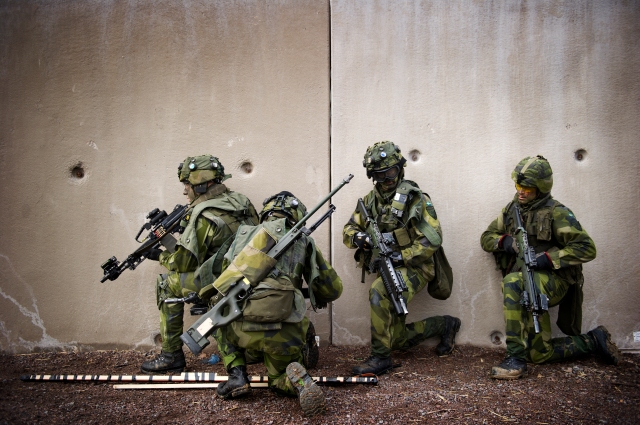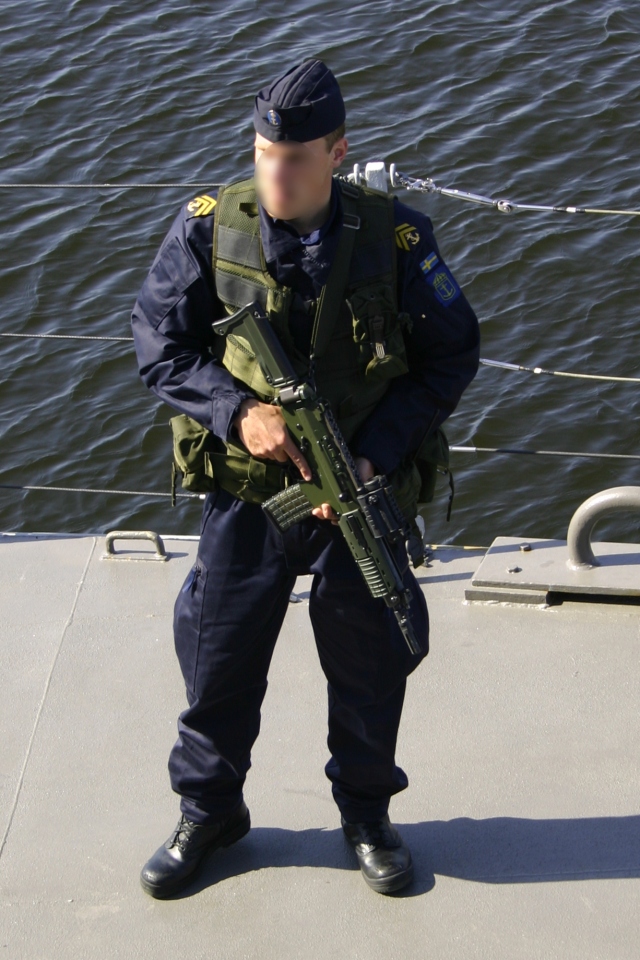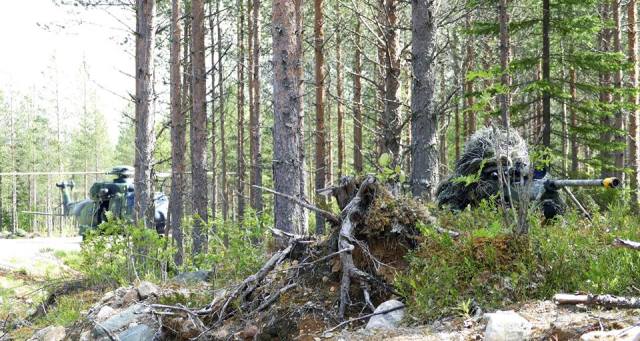Lepukki
Eversti
Pikasäädettävä 2-pistehihna? Kuulostaa hyvältä. Itseltänikin löytyy Blue Force Gearin vastaava, tosin toppauksilla joihin menee vain hermo kun hihna ei liu'u yhtä helposti tarvittaessa.Jätän tämän tähän
Katso liite: 28990
Follow along with the video below to see how to install our site as a web app on your home screen.
Note: This feature may not be available in some browsers.
Pikasäädettävä 2-pistehihna? Kuulostaa hyvältä. Itseltänikin löytyy Blue Force Gearin vastaava, tosin toppauksilla joihin menee vain hermo kun hihna ei liu'u yhtä helposti tarvittaessa.Jätän tämän tähän
Katso liite: 28990
Tuleva hihna on BFG kopio.Jätän tämän tähän
Katso liite: 28990

The Swedish Defence Materiel Administration, FMV, has issued a briefing on the ground forces’ part of their Materiel Plan 20 (hat-tip to HenrikJ on Twitter, FF as we say over there). In short, this is a look at a number of weapons and systems the Army will need in the next few year. Notable is that they are funded inside the current budget and quantities correspond to the current size of the Swedish Defence Forces. And because everyone loves a spirited calibre war, the thing that caught my eye was the plan to swap out all firearms at the squad level.

 corporalfrisk.com
corporalfrisk.com





Nosto Corporal Friskin artikkeli Sveedujen uusista asesuunnitelmista, boldaus minun
Koko artikkeli:

Weapons & Ammunition
The Swedish Defence Materiel Administration, FMV, has issued a briefing on the ground forces’ part of their Materiel Plan 20 (hat-tip to HenrikJ on Twitter, FF as we say over there). In short…corporalfrisk.com
The Swedish Defence Materiel Administration, FMV, has issued a briefing on the ground forces’ part of their Materiel Plan 20 (hat-tip to HenrikJ on Twitter, FF as we say over there). In short, this is a look at a number of weapons and systems the Army will need in the next few year. Notable is that they are funded inside the current budget and quantities correspond to the current size of the Swedish Defence Forces. And because everyone loves a spirited calibre war, the thing that caught my eye was the plan to swap out all firearms at the squad level.
A half-squad from the 422. Company at the MOUT training facility in Kvarn showing the current weapons of Swedish regular units. Left to right: Ksp 90, Psg 90 (on back), and Ak 5C with and without grenade launcher. Source: Nicklas Gustafsson/Swedish Defence Forces
The weapons includes Ak 4 (H&K G3), Ak 5 (FN FNC), Psg 90 (AI Arctic Warfare/L96A1), and the Ksp 90 (FN Minimi). In addition, a designated marksman rifle is to be acquired. Of these, the Ak 4 is the old main service rifle, currently it is mainly used by the Home Guard. The other four weapons are the main squad level weapons of the regular force.
The most prolific weapon of the Swedish forces is without doubt the Ak 5. Contrary to the earlier FN FAL, the 5.56 NATO chambered FNC was a limited success, with Sweden being the only western country to acquire it outside of its native Belgium. In Swedish trials the FNC beat a modified Galil SAR and was adopted in the winter of 1986/1987, making Sweden a pioneer when it came to switching from 7.62 mm to 5.56 mm. The Ak 5 was license-produced in Eskilstuna, and from the get go it has been featuring unique Swedish modifications, spawning a family of it’s own compared to the baseline FNC. In total, approximately 27,500 of the latest version Ak 5C/D were ordered.
Swedish sailor standing guard with his short-barreled Ak 5D aboard a Swedish corvette during a port call in Finland in 2010. Source: Own picture
The other weapons have scored more notable export successes. The Minimi, or M249 SAW which it is still best known as (although the ‘SAW’ has officially been changed), was the outcome of the decision to create a light machine gun able to use the same ammunition as the rest of the squad, i.e. the 5.56 NATO round. It is not a bad weapon per se, but it certainly lack the firepower of light machine guns chambered in 7.62 NATO. The Arctic Warfare is your basic sniper rifle in 7.62 NATO. Accurate, big power optics, costs an arm and a leg, but crucially makes it possible for a trained sniper to hit individual targets out to 1,000 meters.
The interesting part is that the briefing emphasised that the requirements are to be focused on the “system”. While this shouldn’t be read as a single weapon doing everything, it does offer an edge to any supplier able to cater to all or several of the four weapons needed (assault rifle, designated marksman rifle, light machine gun, and sniper rifle). However, a split buy likely isn’t ruled out (especially when it comes to the sniper rifle). The programme, including trials, will take place during 2019 to 2024 with the main deliveries starting in 2025. A total of 2.2 billion SEK (210 million Euro) is allocated for the 2021 to 2030 period.
If we start from the most basic weapon, the assault rifle (likely in full-length and carbine length versions) will likely be a new 5.56 NATO weapon. For quite some time there has been new wonder-rounds appearing with tiresome regularity, but despite the praise calibres such as .300 BLK or 6.8 SPC has garnered from firearms aficionados, love is waiting to blossom out when it comes to these wildcat(ish) rounds and the greater defence community. The reason is not that they would be bad, but rather that the task of switching away from 5.56 NATO which has become the de facto western standard to something else causes major disruptions when it comes to logistics and interoperability. As such, I don’t foresee a shift away from the 5.56 NATO for most Swedish soldiers.
In the same way it would be very surprising if the designated marksman rifle is anything else than a 7.62 NATO weapon. The round excels in combining a relatively manageable recoil and a reach out beyond that of the 5.56 NATO, while at the same time being in widespread use both amongst military, law enforcement, and civilian users.
The light machine gun is a more interesting one. The FN MAG is in Swedish use as the Ksp 58, though the versions available are quite old (read: heavy), and in its current guise likely won’t migrate down to fill the squad level-role. However, stepping up from 5.56 NATO to 7.62 NATO is entirely possible, especially as the designated marksman weapon likely will bring the calibre into widespread use anyhow (though sharing ammunition between the DM and the machine gunner will likely stay an emergency measure only).
Finnish military police sniper covering a helicopter landing zone. The weapon is the Sako TRG-42 chambered in .338 LM, or 8.6 TKIV 2000 as it is locally known. Source: Maavoimat FB
For the sniper rifle, while 7.62 NATO has long been the standard round, I find it highly likely that the new weapon will follow international trends a go up a notch to .338 LM. It does allow for longer shots compared to the 7.62 NATO, but the big benefit is that it is more forgiving at the ranges beyond a few hundred meters, thanks to the better ballistics and higher hitting power. On the downside both weapons and rounds are significantly more expensive, and it would mean adopting a completely new round into Swedish service.
The Contenders
To begin with, let’s not pretend that there is any single obvious choice for any single one of the weapons. With that said, some weapons certainly would be less surprising than others. Notable is the fact that there are no Swedish gunmaker able of handling even license production of the order following the closure of the Eskilstuna rifleworks in 2012.
Belgian special forces operator with a SCAR-L. Source: Lithiummm01 via Wikimedia Commons
FN Herstal has an interesting arsenal to offer. The FN-SCAR is widely seen as one of the best assault rifles currently in use. It is offered in numerous configurations, including the basic SCAR-L (available with both 14.5” and 10” barrels) and the sub-compact SCAR SC (7.5” barrel), as well as the SCAR-H in 7.62 NATO (available in the PR designated marksman/semi-auto sniper version). FN Herstal also has a number of options for the machine gun, offering the modernised MINIMI Mk3 in both 5.56 NATO and 7.62 NATO as well as numerous versions of the earlier mentioned FN MAG in 7.62 NATO. The SCAR has received several orders, but mostly from elite units (including the Finnish Special Jaegers) and scoring noticeably worse when it comes to larger orders for general service rifles.
In the same way, Heckler & Koch has an impressive array. The HK416 (5.56 NATO) and HK417 (7.62 NATO) is a duet that has secured an impressive string of orders. The biggest gem in this string of pearls is without doubt the decision by France to replace their homemade FAMAS with the German design. Closer to home, Norway has adopted them as well. The weapons are based on the classic AR-design, but feature a short-stroke piston. For the German G36C replacement, H&K has offered the newer HK433 instead, which is available in numerous configurations. So far it has failed to receive any orders, but in case it does become the main German assault rifle the outlook for the rifle could change overnight. HK also have the MG4 in 5.56 NATO and MG5 in 7.62 NATO when it comes to machine guns, and the G28 designated marksman rifle version of the HK417.
Haenel MK 556 is the other contender for the German contract. The company has a more civilian portfolio, with machine guns being absent. They do however, offer a number of 7.62 NATO chambered rifles which are suitable for marksman duty.
Other obvious contenders are more traditional versions of the AR-family which are available from numerous manufacturers, including the Lewis Machine & Tool Company which recently secured the contract to replace Estonia’s Ak 4s (though the order has been challenged in court).
As is evident from the rundown above, the one weapon missing is a bolt-action sniper rifle, with the others usually having the option of being found from a single manufacturer. Quite a number of .338 LM sniper rifles are found on the market, with the Sako TRG-42 likely being the market leader, but there are several others in use such as the AWM in British service as the L115A3 (the AWM is now replaced by the AXMC, which likely will be the contender for a Swedish order) or the McMillian TAC-338.
Meanwhile, in Finland
Source: EriKolaborator via Wikimedia Commons
Tumbleweeds. Crickets. The ghosts of Butch Cassidy and the Sundance Kid riding by in the distance.
During a century of Finnish Defence Forces, a total of two platforms have been the main weapons of the Finnish infantry: the Mosin-Nagant M91 (that’s 1891) and the AK-family of assault rifles. And while the M91-family is slowly being retired (a sniper rifle built on the original receivers is still around), the AK-clones are set to overdo their stay.
“But wait”, my trusty old Rk 62 says. “Don’t you remember when we scored a perfect 20 on the rifle qualification? That was how I made you love me!”
The Rk 62 and the newer Rk 95 TP are arguably some of the best AK-clones available in 7.62×39 mm, being machined and featuring details such as the rear sight being moved further back for a more accurate sight picture thanks to tighter tolerances. The weapon is accurate enough when you have time to find a good firing stance and shoot at 75 meters. Still, there’s no denying that both the platform and calibres are getting old. The updated Rk 62M is better, especially thanks to the improved stock and the Aimpoint Comp M4 sight combining to make quick shots and recoil management easier. Still, it is largely a question of coating a dated design in a liberal amount of sugar and calling it sweet. And to make matters worse, a large number of wartime Finnish troops would not get a Finnish-built weapon, but one of any number of East German and Chinese AKM-copies which have been bought in droves to equip the second and third line troops.
For a long time I have been arguing against introducing a new assault weapon for the Finnish Defence Forces. Rifles generally age well, and if one has to choose between introducing a new rifle with a new main calibre against something like the 155 K9 Moukari artillery system, the new SPGs are the obvious choice. However, we are moving towards the point in time when waiting is no longer an option. As such, we could certainly do worse than ensuring an option to piggyback off the Swedish firearms trials in the same way the Estonian Defence Forces bought their K9s under the same contract as the Finnish artillery. Buying the same assault rifles, designated marksman rifles, and machine guns as Sweden would allow us to phase out a large number of the worst AK-clones, the Dragunovs and possibly the last 7.62 TKIV 85, as well as the 7.62 KvKK 62 light machine guns. The 7.62 PKM is still a modern weapon, so there is no need to replace those. However, additional buys are a no-no after Crimea.
I hereby suggest a study into how piggybacking upon the Swedish firearms program with a 450 million Euro program of our own could increase the lethality of the Finnish infantry. This ought to be funded outside of the normal defence budgets, in line with other ongoing strategic acquisitions.
Olisipa kova juttu, jos näin olisi.Voisiko tämä jotenkin liittyä näihin huhuihin Sako:n aikeista aloittaa M4/AR-15 kloonin valmistus?
Noita AR-15 klooneja on markkinoilla jo ihan tarpeeksi.. Ei jatkoon..Voisiko tämä jotenkin liittyä näihin huhuihin Sako:n aikeista aloittaa M4/AR-15 kloonin valmistus?
Noita AR-15 klooneja on markkinoilla jo ihan tarpeeksi.. Ei jatkoon..
Tuotapa en tiennytkään. KiinnostavaaKatso liite: 29328
Tämä varmaan aiheuttaa keskustelua, ase- utran vaimennin tulee paketissa

Ei mikään suuren suuri vaimennin, paljonkohan sen vaimennusteho on?Katso liite: 29328
Tämä varmaan aiheuttaa keskustelua, ase- utran vaimennin tulee paketissa
Ei mikään suuren suuri vaimennin, paljonkohan sen vaimennusteho on?
Taitaa olla vaimentimen ”nokka” muotoiltu niin, että voidaan käyttää murtoammuntaan?
JepTarkoitatko lukkojen ampumista?
Räyhäkkä olemus. Erittäin käytännöllisiä ratkaisuja osuu silmään useampi.Katso liite: 29328
Tämä varmaan aiheuttaa keskustelua, ase- utran vaimennin tulee paketissa
Katso liite: 29328
Tämä varmaan aiheuttaa keskustelua, ase- utran vaimennin tulee paketissa
